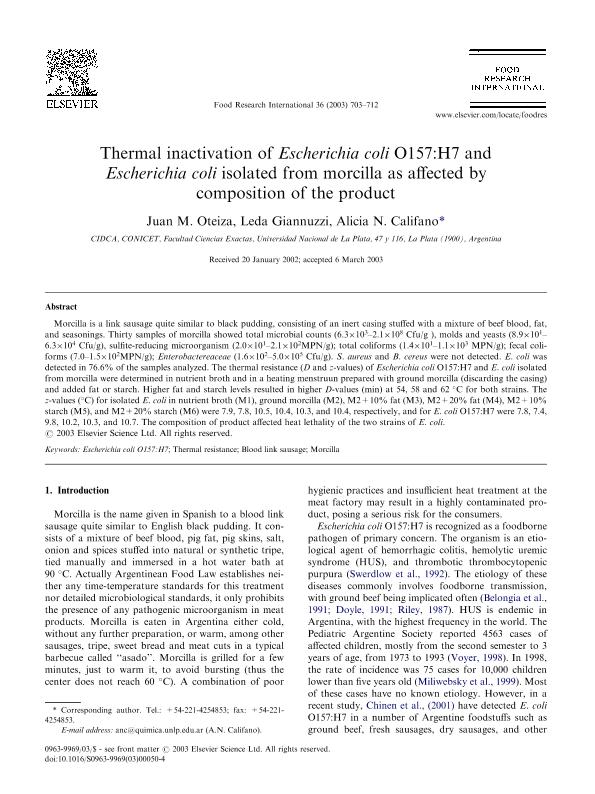Artículo
Thermal inactivation of Escherichia coli O157:H7 and Escherichia coli isolated from morcilla as affected by composition of the product
Fecha de publicación:
08/2003
Editorial:
Elsevier Science
Revista:
Food Research International
ISSN:
0963-9969
Idioma:
Inglés
Tipo de recurso:
Artículo publicado
Clasificación temática:
Resumen
Morcilla is a link sausage quite similar to black pudding, consisting of an inert casing stuffed with a mixture of beef blood, fat, and seasonings. Thirty samples of morcilla showed total microbial counts (6.3×103–2.1×108 Cfu/g ), molds and yeasts (8.9×101–6.3×104 Cfu/g), sulfite-reducing microorganism (2.0×101–2.1×102MPN/g); total coliforms (1.4×101–1.1×103 MPN/g); fecal coliforms (7.0–1.5×102MPN/g); Enterobactereaceae (1.6×102–5.0×105 Cfu/g). S. aureus and B. cereus were not detected. E. coli was detected in 76.6% of the samples analyzed. The thermal resistance (D and z-values) of Escherichia coli O157:H7 and E. coli isolated from morcilla were determined in nutrient broth and in a heating menstruun prepared with ground morcilla (discarding the casing) and added fat or starch. Higher fat and starch levels resulted in higher D-values (min) at 54, 58 and 62 °C for both strains. The z-values (°C) for isolated E. coli in nutrient broth (M1), ground morcilla (M2), M2+10% fat (M3), M2+20% fat (M4), M2+10% starch (M5), and M2+20% starch (M6) were 7.9, 7.8, 10.5, 10.4, 10.3, and 10.4, respectively, and for E. coli O157:H7 were 7.8, 7.4, 9.8, 10.2, 10.3, and 10.7. The composition of product affected heat lethality of the two strains of E. coli.
Palabras clave:
BLOOD LINK SAUSAGE
,
ESCHERICHIA COLI O157:H7
,
MORCILLA
,
THERMAL RESISTANCE
Archivos asociados
Licencia
Identificadores
Colecciones
Articulos(CIDCA)
Articulos de CENTRO DE INV EN CRIOTECNOLOGIA DE ALIMENTOS (I)
Articulos de CENTRO DE INV EN CRIOTECNOLOGIA DE ALIMENTOS (I)
Citación
Oteiza, Juan Martín; Giannuzzi, Leda; Califano, Alicia Noemi; Thermal inactivation of Escherichia coli O157:H7 and Escherichia coli isolated from morcilla as affected by composition of the product; Elsevier Science; Food Research International; 36; 7; 8-2003; 703-712
Compartir
Altmétricas




